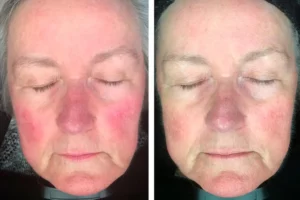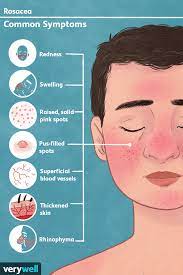What is Rosacea and how can it be managed?
Rosacea is a chronic skin condition that affects millions of people worldwide. It is characterized by redness, flushing, and bumps on the face, which can be embarrassing and cause a great deal of self-consciousness. While the exact cause of rosacea is not fully understood, there are several factors that are believed to contribute to its development. In this article, we will explore the top seven reasons why people develop rosacea.
Genetics
Research has shown that rosacea may have a genetic component. Studies have found that people with a family history of rosacea are more likely to develop the condition themselves. In fact, it is estimated that up to 40% of people with rosacea have a family member who also has the condition. While genetics cannot be changed, being aware of a family history of rosacea can help people take preventative measures to avoid triggers that can exacerbate the condition.

Abnormalities in the Blood Vessels
Abnormalities in the blood vessels of the face are believed to be a significant contributor to rosacea. These abnormalities cause the blood vessels to dilate more easily, leading to redness, flushing, and visible blood vessels on the face. Some researchers believe that these abnormalities may be related to a malfunction in the body’s immune system. These broken blood vessels are often called thread veins or spide veins.
Demodex Mites
Demodex mites are tiny, microscopic organisms that live in the hair follicles of the skin. While they are present in most people, those with rosacea tend to have higher numbers of these mites. It is believed that the presence of these mites may cause an inflammatory response in the skin, leading to the development of rosacea.
Environmental Triggers
Environmental triggers are factors that can exacerbate the symptoms of rosacea. These can include exposure to sunlight, wind, and extreme temperatures. Some people with rosacea also report that certain foods, beverages, and medications can trigger flare-ups. Jacqui Bannister of the Skin Revision Clinic says “sunlight is a significant cause of rosacea for many of her clients. For those who have been continually exposed to the UVA and UVB rays, rosacea symptoms will often show themselves after a number of years. They will be particularly noticeable on the nose and cheeks.”
Alcohol Consumption
Alcohol consumption is not a direct cause of rosacea, but it can exacerbate symptoms in people who already have the condition. Alcohol causes blood vessels to dilate, which can lead to redness and flushing. This redness often shows on the forehead, the cheeks, the nose, the chin and the neck. Thread veins or broken blood capillaries often show themselves within the rosacea areas, when alcohol is consumed over a period of time. Additionally, many alcoholic beverages, such as red wine and beer, contain histamines and sulfites, which are known to trigger rosacea symptoms in some people.
Hormonal Changes
Hormonal changes can also contribute to the development of rosacea. Women are more likely than men to develop the condition. Many women report that their symptoms worsen during pregnancy or menopause. Hormonal changes may cause an inflammatory response in the skin which leads to the onset of rosacea.
Stress
Stress is a common trigger for many skin conditions, including rosacea. When the body is under stress, it releases hormones that can cause blood vessels to dilate. This leads to redness and flushing in the cheeks, on the forehead, on the nose, around the chin and on areas of the neck. Additionally, stress can weaken the immune system, making the body more susceptible to inflammation and infection.

In conclusion, while the exact cause of rosacea is not fully understood, there are several factors that are believed to contribute to its development. These include genetics, abnormalities in the blood vessels, demodex mites, environmental triggers, alcohol consumption, hormonal changes, and stress. By understanding these factors, people with rosacea can take steps to manage their condition and reduce the frequency and severity of their symptoms. These options may well help reduce or in some cases remove the rosacea: changes to your lifestyle and your environment, prescribed topical creams, or seeking a skin care professional who specifically works with clients who have symptoms of Rosacea.
A typical and well know skin clinic would be the skin clinic in Buckinghamshire, called the Skin Revision Clinic.
If you are experiencing symptoms of rosacea, it is important to speak with the Skin Revision Clinic. They will help you develop a personalized treatment plan and educate you in how to manage your symptoms at home and improve your quality of life.



